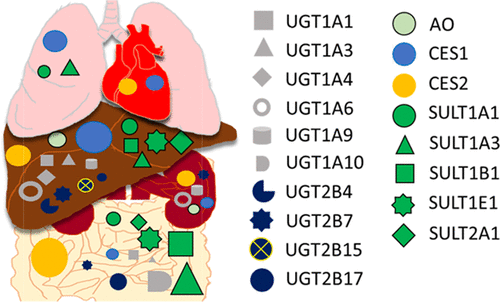当前位置:
X-MOL 学术
›
Mol. Pharmaceutics
›
论文详情
Our official English website, www.x-mol.net, welcomes your
feedback! (Note: you will need to create a separate account there.)
CHARACTERIZATION OF DIFFERENTIAL TISSUE ABUNDANCE OF MAJOR NON-CYP ENZYMES IN HUMAN.
Molecular Pharmaceutics ( IF 4.5 ) Pub Date : 2020-09-21 , DOI: 10.1021/acs.molpharmaceut.0c00559 Abdul Basit 1 , Naveen K Neradugomma 2 , Christopher Wolford 2 , Peter W Fan 3 , Bernard Murray 4 , Ryan H Takahashi 5 , S Cyrus Khojasteh 5 , Bill J Smith 4 , Scott Heyward 6 , Rheem A Totah 7 , Edward J Kelly 2 , Bhagwat Prasad 1
Molecular Pharmaceutics ( IF 4.5 ) Pub Date : 2020-09-21 , DOI: 10.1021/acs.molpharmaceut.0c00559 Abdul Basit 1 , Naveen K Neradugomma 2 , Christopher Wolford 2 , Peter W Fan 3 , Bernard Murray 4 , Ryan H Takahashi 5 , S Cyrus Khojasteh 5 , Bill J Smith 4 , Scott Heyward 6 , Rheem A Totah 7 , Edward J Kelly 2 , Bhagwat Prasad 1
Affiliation

|
The availability of assays that predict the contribution of cytochrome P450 (CYP) metabolism allows for the design of new chemical entities (NCEs) with minimal oxidative metabolism. These NCEs are often substrates of non-CYP drug-metabolizing enzymes (DMEs), such as UDP-glucuronosyltransferases (UGTs), sulfotransferases (SULTs), carboxylesterases (CESs), and aldehyde oxidase (AO). Nearly 30% of clinically approved drugs are metabolized by non-CYP enzymes. However, knowledge about the differential hepatic versus extrahepatic abundance of non-CYP DMEs is limited. In this study, we detected and quantified the protein abundance of eighteen non-CYP DMEs (AO, CES1 and 2, ten UGTs, and five SULTs) across five different human tissues. AO was most abundantly expressed in the liver and to a lesser extent in the kidney; however, it was not detected in the intestine, heart, or lung. CESs were ubiquitously expressed with CES1 being predominant in the liver, while CES2 was enriched in the small intestine. Consistent with the literature, UGT1A4, UGT2B4, and UGT2B15 demonstrated liver-specific expression, whereas UGT1A10 expression was specific to the intestine. UGT1A1 and UGT1A3 were expressed in both the liver and intestine; UGT1A9 was expressed in the liver and kidney; and UGT2B17 levels were significantly higher in the intestine than in the liver. All five SULTs were detected in the liver and intestine, and SULT1A1 and 1A3 were detected in the lung. Kidney abundance was the most variable among the studied tissues, and overall, high interindividual variability (>15-fold) was observed for UGT2B17, CES2 (intestine), SULT1A1 (liver), UGT1A9, UGT2B7, and CES1 (kidney). These differential tissue abundance data can be integrated into physiologically based pharmacokinetic (PBPK) models for the prediction of non-CYP drug metabolism and toxicity in hepatic and extrahepatic tissues.
中文翻译:

人类主要非CYP酶的差异组织丰度的表征。
预测细胞色素 P450 (CYP) 代谢贡献的分析的可用性允许设计具有最小氧化代谢的新化学实体 (NCE)。这些 NCE 通常是非 CYP 药物代谢酶 (DME) 的底物,例如 UDP-葡萄糖醛酸转移酶 (UGT)、磺基转移酶 (SULT)、羧酸酯酶 (CES) 和醛氧化酶 (AO)。近 30% 的临床批准药物是由非 CYP 酶代谢的。然而,关于非 CYP DME 的肝外丰度差异的知识是有限的。在本研究中,我们检测并量化了 5 种不同人体组织中 18 种非 CYP DME(AO、CES1 和 2、10 种 UGT 和 5 种 SULT)的蛋白质丰度。AO 在肝脏中表达最多,在肾脏中表达较少;然而,它在肠道、心脏或肺中均未检测到。CES 普遍表达,CES1 在肝脏中占主导地位,而 CES2 在小肠中富集。与文献一致,UGT1A4、UGT2B4 和 UGT2B15 表现出肝脏特异性表达,而 UGT1A10 表达则是肠道特异性的。UGT1A1和UGT1A3在肝脏和肠道中均有表达;UGT1A9在肝脏和肾脏中表达;肠道中的 UGT2B17 水平显着高于肝脏。在肝脏和肠道中检测到所有 5 种 SULT,在肺中检测到 SULT1A1 和 1A3。在所研究的组织中,肾脏丰度是变化最大的,并且总体上观察到 UGT2B17、CES2(肠道)、SULT1A1(肝脏)、UGT1A9、UGT2B7 和 CES1(肾脏)的高个体间变异性(>15 倍)。
更新日期:2020-11-02
中文翻译:

人类主要非CYP酶的差异组织丰度的表征。
预测细胞色素 P450 (CYP) 代谢贡献的分析的可用性允许设计具有最小氧化代谢的新化学实体 (NCE)。这些 NCE 通常是非 CYP 药物代谢酶 (DME) 的底物,例如 UDP-葡萄糖醛酸转移酶 (UGT)、磺基转移酶 (SULT)、羧酸酯酶 (CES) 和醛氧化酶 (AO)。近 30% 的临床批准药物是由非 CYP 酶代谢的。然而,关于非 CYP DME 的肝外丰度差异的知识是有限的。在本研究中,我们检测并量化了 5 种不同人体组织中 18 种非 CYP DME(AO、CES1 和 2、10 种 UGT 和 5 种 SULT)的蛋白质丰度。AO 在肝脏中表达最多,在肾脏中表达较少;然而,它在肠道、心脏或肺中均未检测到。CES 普遍表达,CES1 在肝脏中占主导地位,而 CES2 在小肠中富集。与文献一致,UGT1A4、UGT2B4 和 UGT2B15 表现出肝脏特异性表达,而 UGT1A10 表达则是肠道特异性的。UGT1A1和UGT1A3在肝脏和肠道中均有表达;UGT1A9在肝脏和肾脏中表达;肠道中的 UGT2B17 水平显着高于肝脏。在肝脏和肠道中检测到所有 5 种 SULT,在肺中检测到 SULT1A1 和 1A3。在所研究的组织中,肾脏丰度是变化最大的,并且总体上观察到 UGT2B17、CES2(肠道)、SULT1A1(肝脏)、UGT1A9、UGT2B7 和 CES1(肾脏)的高个体间变异性(>15 倍)。











































 京公网安备 11010802027423号
京公网安备 11010802027423号